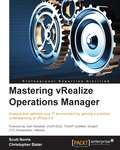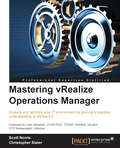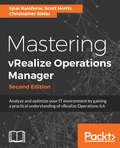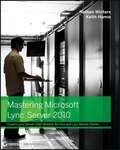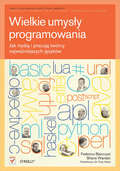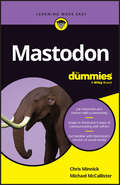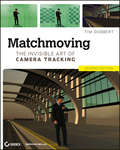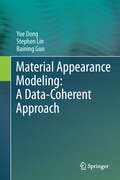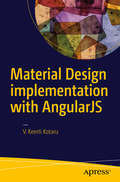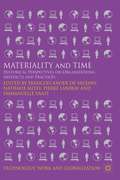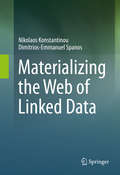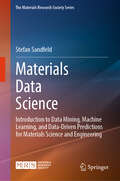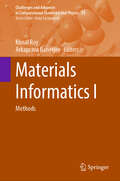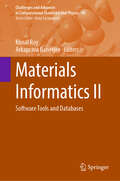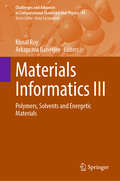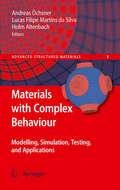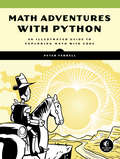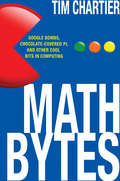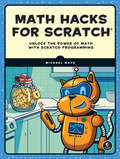- Table View
- List View
Mastering vRealize Automation 6.2
by J. PowellEnable virtualization, automation, and efficient cloud management in your environment with vRealize Automation 6.2 About This Book * Learn the best practices of system architecture and design of the newly released vRealize Automation 6.2 * Resolve common pitfalls during the configuration and customization process by exploring complex topics such as cloud provisioning * An easy-to-follow guide that will help you to become the go-to person for vRealize Automation in your organization Who This Book Is For Mastering vRealize Automation 6.2 is intended for readers who already have advanced knowledge of vCenter and want to utilize automation and orchestration to provision their infrastructure. However, no previous experience with vRealize Automation is necessary. If you want design best practices, step-by-step implementation guidance, and real world configuration examples, this book will be the perfect companion. What You Will Learn * Master Installation, configuration, and customization vRealize Automation 6.2 * Integrate SCCM, Kickstart, and WIM deployment servers with vRealize Automation * Easy-to-follow integration steps for using vRealize Orchestrator, Operations Manager, and Application Services with vRealize Automation 6.2 * Avoid common pitfalls during the configuration and customization process * Integrate vRealize Application Services and Orchestrator * vRealize Automation design concepts and best practices for small, medium, or large enterprise environments * Create Approval Policies to govern the amount of resources end users can consume when provisioning infrastructure * Create multiple machine blueprints to leverage the existing deployment methods in your environment In Detail vRealize Automation 6.2 orchestrates the provisioning of infrastructure, applications, and customized services delivered from a self-service web portal. Administrators provide end users resources to consume, such as Operating Systems, and Applications, through a customized web portal and catalog. From the end user perspective, its like shopping for IT resources through an online merchant portal. Administrators get to offload the repetitive portions of their job, such as building VMs, by creating Blueprints that deploy VMs on demand. This ensures uniformity in the VMs and timeliness in their delivery, while providing agility for the IT team to handle other responsibilities outside of provisioning infrastructure and applications. The book opens with an overview of the history and features of vRealize Automation and moves into the basic components required to set up vRA, as well as some of the best practices. You are guided through the steps to design your vRealize Automation environment and introduced to integration point, including SCCM and Kickstart deployments, as well as Linked Clones. You will learn about Approval Policies and why they are useful for your infrastructure, and how to efficiently set them up. You will learn how to integrate other products, such as vRealize Operations Manager and Orchestrator. Throughout the book, you are provided insights into some of the common errors and pitfalls that occur during installation and maintenance, as well as how to resolve them. Finally, the book provides a valuable list of references to enhance your knowledge of vRealize Automation 6.2. Style and approach An advanced guide filled with real-world examples to master installation, configuration, and customization of vRealize Automation 6.2 and its features such as vRealize Orchestrator and vRealize Application Services.
Mastering vRealize Operations Manager
by Scott Norris Christopher Slater<P><P>Analyze and optimize your IT environment by gaining a practical understanding of vROps 6.0 <P><P>About This Book <P><P>Get complete control of capacity management in your virtual environment <P><P>Display the most appropriate performance metrics and assemble your own dashboard <P><P>Analyze and process data from different sources into a single repository, allowing you to understand every layer of your environment <P><P>Who This Book Is For <P><P>If you are an administrator of a virtual environment and have used vROps before but want to gain a professional understanding by implementing complex tasks easily with it, then this book is for you. <P><P>What You Will Learn <P><P>Discover advanced vROps concepts and design your processes effectively for the underlying architecture <P><P>Migrate from previous versions or install new versions <P><P>Apply proven capacity management theories and techniques in practical, real-world environments <P><P>Manipulate data and metrics to display them in the most effective way possible <P><P>Create custom dashboards fit for any use case <P><P>Make better use of the powerful analytics engine by bringing in external data with third-party adapters and the REST API <P><P>Explore how policies have evolved in vROps 6.0 and how to apply them in the most effective manner <P><P>In Detail <P><P>As x86 server virtualization becomes mainstream for even the most demanding applications, the criticality of managing the heath and efficiency of virtualized environments is more important than ever. vRealize Operations Manager 6.0 (vROps 6.0) is the key to simplify operations of your virtualized environment and move from being reactive to proactive. <P><P>Mastering vRealize Operations Manager 6.0 helps you streamline your processes and customize the environment to suit your needs. You will gain visibility across all devices in the network and retain full control. With easy-to-follow, step-by-step instructions and support images, you will quickly master the ability to manipulate your data and display it in a way that best suits you and the requirements of your colleagues. From the new and impressive vROps 6.0 platform architecture to troubleshooting and capacity planning, this book is aimed at ensuring you get the knowledge to manage your virtualized environment as effectively as possible.
Mastering vRealize Operations Manager
by Scott NorrisIf you are an administrator of a virtual environment and have used vROps before but want to gain a professional understanding by implementing complex tasks easily with it, then this book is for you.
Mastering vRealize Operations Manager: Analyze and optimize your IT environment by gaining a practical understanding of vRealize Operations 6.6, 2nd Edition
by Scott Norris Spas Kaloferov Chris Slater Alasdair CarnieManage vRealize operations manager 6.6 effectively using this comprehensive guide.Key FeaturesGet complete control of capacity management in your virtual environmentDisplay the most appropriate performance metrics and assemble your own dashboardAnalyze and process data from different sources into a single repositoryOptimize vRealize Automation workload placement Book DescriptionIn the modern IT world, the criticality of managing the health, efficiency, and compliance of virtualized environments is more important than ever. With vRealize Operations Manager 6.6, you can make a difference to your business by being reactive rather than proactive.Mastering vRealize Operations Manager helps you streamline your processes and customize the environment to suit your needs. You will gain visibility across all devices in the network and retain full control. With easy-to-follow, step-by-step instructions and support images, you will quickly master the ability to manipulate your data and display it in a way that best suits you and your business or technical requirements. This book not only covers designing, installing, and upgrading vRealize Operations 6.6, but also gives you a deep understanding of its building blocks: badges, alerts, super metrics, views, dashboards, management packs, and plugins. With the new vRealize Operations 6.6 troubleshooting capabilities, capacity planning, intelligent workload placement, and additional monitoring capabilities, this book is aimed at ensuring you get the knowledge to manage your virtualized environment as effectively as possible.What you will learn Discover advanced vRealize Operations concepts and design your processes effectively for the underlying architecture Plan and install a new version or upgrade from a previous one Apply proven capacity management theories and techniques in practical, real-world environments Manipulate data and metrics to display them in the most effective way possible Create custom views and dashboards fit for any use case Explore how policies have evolved in vRealize Operations 6.6 and how to apply them in the most effective mannerWho this book is forIf you are an administrator of a virtual environment and have used vRealize Operations before but want to gain a professional understanding by easily implementing complex tasks with it, then this book is for you.
Mastering: LyncTM Server 2010
by Nathan Winters Keith HannaAn in-depth guide on the leading Unified Communications platform Microsoft Lync Server 2010 maximizes communication capabilities in the workplace like no other Unified Communications (UC) solution. Written by experts who know Lync Server inside and out, this comprehensive guide shows you step by step how to administer the newest and most robust version of Lync Server. Along with clear and detailed instructions, learning is aided by exercise problems and real-world examples of established Lync Server environments. You'll gain the skills you need to effectively deploy Lync Server 2010 and be on your way to gaining all the benefits UC has to offer. Gets you up and running with Lync Server--whether you are migrating from Office Communications Server or new to Lync Server. Walks you through all of the essential stages for deploying Lync Server Shows integration with Microsoft Exchange Server and Microsoft SharePoint Server Demonstrates how to monitor, diagnose, and troubleshoot problems more efficiently Mastering Lync Server 2010 is a must-have resource for anyone looking to manage all the various forms of communication from one user interface.
Masterminds of Programming. Conversations with the Creators of Major Programming Languages
by Federico Biancuzzi i Chromatic<p>Droga od pomys?u do gotowej aplikacji jest d?uga i kr?ta. Najprawdopodobniej jednym z najd?u?szych jej odcinków jest ten po?wi?cony na programowanie. Sztab ludzi, wiele j?zyków ...</p>
Masterminds of Programming: Conversations with the Creators of Major Programming Languages (Theory in Practice (O'Reilly))
by Chromatic Federico BiancuzziMasterminds of Programming features exclusive interviews with the creators of several historic and highly influential programming languages. In this unique collection, you'll learn about the processes that led to specific design decisions, including the goals they had in mind, the trade-offs they had to make, and how their experiences have left an impact on programming today. Masterminds of Programming includes individual interviews with:Adin D. Falkoff: APLThomas E. Kurtz: BASICCharles H. Moore: FORTHRobin Milner: MLDonald D. Chamberlin: SQLAlfred Aho, Peter Weinberger, and Brian Kernighan: AWKCharles Geschke and John Warnock: PostScriptBjarne Stroustrup: C++Bertrand Meyer: EiffelBrad Cox and Tom Love: Objective-CLarry Wall: PerlSimon Peyton Jones, Paul Hudak, Philip Wadler, and John Hughes: HaskellGuido van Rossum: PythonLuiz Henrique de Figueiredo and Roberto Ierusalimschy: LuaJames Gosling: JavaGrady Booch, Ivar Jacobson, and James Rumbaugh: UMLAnders Hejlsberg: Delphi inventor and lead developer of C#If you're interested in the people whose vision and hard work helped shape the computer industry, you'll find Masterminds of Programming fascinating.
Mastodon For Dummies
by Chris Minnick Michael McCallisterA little birdy told us you needed to know more about Mastodon Ready to escape the drama of existing social media platforms and try something new and awesome in the world of social media? In Mastodon For Dummies, experienced tech trainers Chris Minnick and Mike McCallister show you exactly how to use Mastodon, the hot decentralized social media offering on the web and destination for thousands of social media migrants. Learn how to sign up for the service on your choice of server and get familiar with the rules of what’s sure to become your new favorite app. You’ll discover how to connect with other people, attract your own followers, and make yourself right at home in the Mastodon community. In the book, you’ll find: Easy-to-follow instructions on how to choose the Mastodon server that suits you best Instructions for establishing new connections on a new social platform and learning the rules of the road Tips for conducting business on Mastodon and making a home for your home-based business or brand on the social media service Step-by-step guides on launching your very own serverIf you’re ready to leave old social platforms in the rear-view and try something new, grab a copy of Mastodon For Dummies.
Matching Automata: A Degenerated Design (Intelligent Systems Reference Library #271)
by Yoshiteru IshidaWhat does the future of AI hold—a supportive partner or a rival with its own illusion of self? This book explores this critical question by introducing degenerated design, a groundbreaking framework for creating resilient, adaptive systems inspired by natural processes like immunity and collective intelligence. Rejecting traditional optimization-focused AI paradigms, this approach embraces imperfection and diversity as essential for building intelligent systems that thrive in dynamic environments. Spanning industries such as robotics, automotive, biotechnology, quantum computing, and space exploration, the book also ventures into the cognitive dimensions of AI. Inspired by human sensory systems, it proposes a two-sided model, possibly extendable to that of consciousness, exploring the interplay between passive automata and active intentional agents. It delves into the origins and illusions of self-consciousness, examining its survival merits and dangers in both biological and artificial contexts. A must-read for system designers, CEOs, and AI researchers, this book also challenges academics and students to rethink the future of generative AI and antiAI systems. This book is both a technical blueprint and a philosophical exploration of AI’s potential to liberate or confront humanity. The future of human AI coexistence starts here.
Matchmoving
by Tim DobbertGet your foot in the studio door by learning the art of matchmovingMatchmoving is a technique that allows computer graphics to be inserted into live-action footage with correct position, scale, orientation, and motion. Also known as motion tracking, it's what allows movie monsters to run down Main Street and robots to run through crowds--and look real. Now this unique book from a top expert from Industrial Light and Magic teaches you the art of matchmoving.With step-by-step tutorials and pages of examples, this book first explains the basics and then shows you professional techniques, from 3D calibration and tracking, to stereoscopy, and more.Explains concepts and teaches professional techniques for successful matchmoving Authored by a top matchmove specialist from Industrial Light and Magic, who walks you through step-by-step tutorials and impressive examples Covers matchmoving basics, 2D tracking, 3D calibration and tracking, automatic tracking, cameras, integrating matchmoves, and stereoscopyLearn how studio visual effects professionals make all the right matchmoves with Matchmoving: The Invisible Art of Camera Tracking 2nd Edition.
Material Appearance Modeling: A Data-Coherent Approach
by Baining Guo Yue Dong Stephen LinA principal aim of computer graphics is to generate images that look as real as photographs. Realistic computer graphics imagery has however proven to be quite challenging to produce, since the appearance of materials arises from complicated physical processes that are difficult to analytically model and simulate, and image-based modeling of real material samples is often impractical due to the high-dimensional space of appearance data that needs to be acquired. This book presents a general framework based on the inherent coherency in the appearance data of materials to make image-based appearance modeling more tractable. We observe that this coherence manifests itself as low-dimensional structure in the appearance data, and by identifying this structure we can take advantage of it to simplify the major processes in the appearance modeling pipeline. This framework consists of two key components, namely the coherence structure and the accompanying reconstruction method to fully recover the low-dimensional appearance data from sparse measurements. Our investigation of appearance coherency has led to three major forms of low-dimensional coherence structure and three types of coherency-based reconstruction upon which our framework is built. This coherence-based approach can be comprehensively applied to all the major elements of image-based appearance modeling, from data acquisition of real material samples to user-assisted modeling from a photograph, from synthesis of volumes to editing of material properties, and from efficient rendering algorithms to physical fabrication of objects. In this book we present several techniques built on this coherency framework to handle various appearance modeling tasks both for surface reflections and subsurface scattering, the two primary physical components that generate material appearance. We believe that coherency-based appearance modeling will make it easier and more feasible for practitioners to bring computer graphics imagery to life. This book is aimed towards readers with an interest in computer graphics. In particular, researchers, practitioners and students will benefit from this book by learning about the underlying coherence in appearance structure and how it can be utilized to improve appearance modeling. The specific techniques presented in our manuscript can be of value to anyone who wishes to elevate the realism of their computer graphics imagery. For understanding this book, an elementary background in computer graphics is assumed, such as from an introductory college course or from practical experience with computer graphics.
Material Design implementation with AngularJS
by V. Keerti KotaruBuild high-quality web and mobile user interfaces (UI) that are interactive, fluid, and provide a consistent experience across devices from desktops to tablets to smartphones. Use a Material Design approach to position elements and create animations along with principles of the sophisticated AngularJS JavaScript framework. Take advantage of Angular Material, a UI component framework that works out of the box to design web pages that adapt to various screen sizes and adhere to Material Design specifications. What You Will Learn: Develop a UI that adheres to Material Design principles using Angular Material, a UI component framework Use various Angular Material elements, directives, and services in conjunction with CSS3 Flexbox for layout management Use best practice design techniques to develop a responsive UI to fit multiple devices and screen sizes from desktop to tablet to mobile phone Develop web apps for both mobile and desktop form factors and screen sizes using HTML, CSS, and JavaScript Who This Book Is For: Web and mobile app developers with a basic understanding of JavaScript, HTML, and CSS
Material UI Cookbook: Build Captivating User Experiences Using React And Material-ui
by Adam BoduchThey are JavaScript developers who have some basic knowledge of React and would want to implement Material Design principles in React applications using Material UI. The reader wants to build a user interface using React components but doesn’t want to invent their own style or UX framework.
Materiality and Time
by Francois-Xavier de Vaujany Nathalie Mitev Pierre Laniray Emmanuelle VaastSociomaterial research overcomes the dichotomy between social and material worlds by concentrating on organizational practices. These practices are constituted by, but also produce, material and social dynamics. This research is currently having an important impact in management studies and adopts a subjective investigation of time to explore materiality and materialization. Studying the institutional evolution of an organization implies long time spans and it is shown more clearly through the inclusion of material traces of past actions. Materiality and Time is split into three parts: Part I explores how time is materialized and performed in organizations, i. e. how artefacts and material space perform time and temporal dynamics in organizations. Part II examines how organizations and organizational members are constituted by and constitutive of material artefacts. Part III reflects on what a historical perspective on these materializations can bring to the study of organizations. Contributions focus on the materialization of time and the material dynamic of organizations.
Materiality, Rules and Regulation: New Trends in Management and Organization Studies (Technology, Work and Globalization)
by Nathalie Mitev François-Xavier de Vaujany Anouk Mukherjee Giovan LanzaraMateriality, Rules and Regulation: New Trend in Management and Organization Studies concentrates on the relationship of rules and regulation to the materiality of artefacts, practices, and organizations. It combines the recent scholarly interest on sociomateriality with a focus on regulation and rules.
Materializing the Web of Linked Data
by Nikolaos Konstantinou Dimitrios-Emmanuel SpanosThis book explains the Linked Data domain by adopting a bottom-up approach: it introduces the fundamental Semantic Web technologies and building blocks, which are then combined into methodologies and end-to-end examples for publishing datasets as Linked Data, and use cases that harness scholarly information and sensor data. It presents how Linked Data is used for web-scale data integration, information management and search. Special emphasis is given to the publication of Linked Data from relational databases as well as from real-time sensor data streams. The authors also trace the transformation from the document-based World Wide Web into a Web of Data. Materializing the Web of Linked Data is addressed to researchers and professionals studying software technologies, tools and approaches that drive the Linked Data ecosystem, and the Web in general.
Materials Data Science: Introduction to Data Mining, Machine Learning, and Data-Driven Predictions for Materials Science and Engineering (The Materials Research Society Series)
by Stefan SandfeldThis text covers all of the data science, machine learning, and deep learning topics relevant to materials science and engineering, accompanied by numerous examples and applications. Almost all methods and algorithms introduced are implemented “from scratch” using Python and NumPy. The book starts with an introduction to statistics and probabilities, explaining important concepts such as random variables and probability distributions, Bayes’ theorem and correlations, sampling techniques, and exploratory data analysis, and puts them in the context of materials science and engineering. Therefore, it serves as a valuable primer for both undergraduate and graduate students, as well as a review for research scientists and practicing engineers. The second part provides an in-depth introduction of (statistical) machine learning. It begins with outlining fundamental concepts and proceeds to explore a variety of supervised learning techniques for regression and classification, including advanced methods such as kernel regression and support vector machines. The section on unsupervised learning emphasizes principal component analysis, and also covers manifold learning (t-SNE and UMAP) and clustering techniques. Additionally, feature engineering, feature importance, and cross-validation are introduced. The final part on neural networks and deep learning aims to promote an understanding of these methods and dispel misconceptions that they are a “black box”. The complexity gradually increases until fully connected networks can be implemented. Advanced techniques and network architectures, including GANs, are implemented “from scratch” using Python and NumPy, which facilitates a comprehensive understanding of all the details and enables the user to conduct their own experiments in Deep Learning.
Materials Discovery and Design: By Means of Data Science and Optimal Learning (Springer Series in Materials Science #280)
by Turab Lookman Frank Alexander Stephan Eidenbenz Cris BarnesThis book addresses the current status, challenges and future directions of data-driven materials discovery and design. It presents the analysis and learning from data as a key theme in many science and cyber related applications. The challenging open questions as well as future directions in the application of data science to materials problems are sketched. Computational and experimental facilities today generate vast amounts of data at an unprecedented rate. The book gives guidance to discover new knowledge that enables materials innovation to address grand challenges in energy, environment and security, the clearer link needed between the data from these facilities and the theory and underlying science. The role of inference and optimization methods in distilling the data and constraining predictions using insights and results from theory is key to achieving the desired goals of real time analysis and feedback. Thus, the importance of this book lies in emphasizing that the full value of knowledge driven discovery using data can only be realized by integrating statistical and information sciences with materials science, which is increasingly dependent on high throughput and large scale computational and experimental data gathering efforts. This is especially the case as we enter a new era of big data in materials science with the planning of future experimental facilities such as the Linac Coherent Light Source at Stanford (LCLS-II), the European X-ray Free Electron Laser (EXFEL) and MaRIE (Matter Radiation in Extremes), the signature concept facility from Los Alamos National Laboratory. These facilities are expected to generate hundreds of terabytes to several petabytes of in situ spatially and temporally resolved data per sample. The questions that then arise include how we can learn from the data to accelerate the processing and analysis of reconstructed microstructure, rapidly map spatially resolved properties from high throughput data, devise diagnostics for pattern detection, and guide experiments towards desired targeted properties. The authors are an interdisciplinary group of leading experts who bring the excitement of the nascent and rapidly emerging field of materials informatics to the reader.
Materials Informatics I: Methods (Challenges and Advances in Computational Chemistry and Physics #39)
by Kunal Roy Arkaprava BanerjeeThis contributed volume explores the integration of machine learning and cheminformatics within materials science, focusing on predictive modeling techniques. It begins with foundational concepts in materials informatics and cheminformatics, emphasizing quantitative structure-property relationships (QSPR). The volume then presents various methods and tools, including advanced QSPR models, quantitative read-across structure-property relationship (q-RASPR) models, optimization strategies with minimal data, and in silico studies using different descriptors. Additionally, it explores machine learning algorithms and their applications in materials science, alongside innovative modeling approaches for quantum-theoretic properties. Overall, the book serves as a comprehensive resource for understanding and applying machine learning in the study and development of advanced materials and is a useful tool for students, researchers and professionals working in these areas.
Materials Informatics II: Software Tools and Databases (Challenges and Advances in Computational Chemistry and Physics #40)
by Kunal Roy Arkaprava BanerjeeThis contributed volume explores the application of machine learning in predictive modeling within the fields of materials science, nanotechnology, and cheminformatics. It covers a range of topics, including electronic properties of metal nanoclusters, carbon quantum dots, toxicity assessments of nanomaterials, and predictive modeling for fullerenes and perovskite materials. Additionally, the book discusses multiscale modeling and advanced decision support systems for nanomaterial risk management, while also highlighting various machine learning tools, databases, and web platforms designed to predict the properties of materials and molecules. It is a comprehensive guide and a great tool for researchers working at the intersection of machine learning and material sciences.
Materials Informatics III: Polymers, Solvents and Energetic Materials (Challenges and Advances in Computational Chemistry and Physics #41)
by Kunal Roy Arkaprava BanerjeeThis contributed volume focuses on the application of machine learning and cheminformatics in predictive modeling for organic materials, polymers, solvents, and energetic materials. It provides an in-depth look at how machine learning is utilized to predict key properties of polymers, deep eutectic solvents, and ionic liquids, as well as to improve safety and performance in the study of energetic and reactive materials. With chapters covering polymer informatics, quantitative structure–property relationship (QSPR) modeling, and computational approaches, the book serves as a comprehensive resource for researchers applying predictive modeling techniques to advance materials science and improve material safety and performance.
Materials with Complex Behaviour
by Lucas F. Silva Holm AltenbachThe increasing demand for materials with superb properties in all types of technical applications requires the development of advanced materials and respective tools to characterise and predict the material properties and behaviour. This monograph highlights the latest developments and trends in advanced materials and their properties, the modelling and simulation of non-classical materials and structures, and new technologies for joining materials.
Math Adventures with Python: An Illustrated Guide to Exploring Math with Code
by Peter FarrellLearn math by getting creative with code! Use the Python programming language to transform learning high school-level math topics like algebra, geometry, trigonometry, and calculus!Math Adventures with Python will show you how to harness the power of programming to keep math relevant and fun. With the aid of the Python programming language, you'll learn how to visualize solutions to a range of math problems as you use code to explore key mathematical concepts like algebra, trigonometry, matrices, and cellular automata.Once you've learned the programming basics like loops and variables, you'll write your own programs to solve equations quickly, make cool things like an interactive rainbow grid, and automate tedious tasks like factoring numbers and finding square roots. You'll learn how to write functions to draw and manipulate shapes, create oscillating sine waves, and solve equations graphically. You'll also learn how to: - Draw and transform 2D and 3D graphics with matrices- Make colorful designs like the Mandelbrot and Julia sets with complex numbers- Use recursion to create fractals like the Koch snowflake and the Sierpinski triangle- Generate virtual sheep that graze on grass and multiply autonomously - Crack secret codes using genetic algorithms As you work through the book's numerous examples and increasingly challenging exercises, you'll code your own solutions, create beautiful visualizations, and see just how much more fun math can be!
Math Bytes: Google Bombs, Chocolate-Covered Pi, and Other Cool Bits in Computing
by Tim P. ChartierAn inviting collection of fun, hands-on applications in mathematics and computingThis book provides a fun, hands-on approach to learning how mathematics and computing relate to the world around us and help us to better understand it. How can reposting on Twitter kill a movie's opening weekend? How can you use mathematics to find your celebrity look-alike? What is Homer Simpson’s method for disproving Fermat’s Last Theorem? Each topic in this refreshingly inviting book illustrates a famous mathematical algorithm or result--such as Google’s PageRank and the traveling salesman problem--and the applications grow more challenging as you progress through the chapters. But don’t worry, helpful solutions are provided each step of the way.Math Bytes shows you how to do calculus using a bag of chocolate chips, and how to prove the Euler characteristic simply by doodling. Generously illustrated in color throughout, this lively and entertaining book also explains how to create fractal landscapes with a roll of the dice, pick a competitive bracket for March Madness, decipher the math that makes it possible to resize a computer font or launch an Angry Bird--and much, much more. All of the applications are presented in an accessible and engaging way, enabling beginners and advanced readers alike to learn and explore at their own pace--a bit and a byte at a time.
Math Hacks for Scratch: Unlock the Power of Math with Scratch Programming
by Michael MaysPush Scratch programming to the limits as you explore primes, Fibonacci numbers, Pascal&’s triangle, and other mathematical curiosities through hands-on coding projects.If you&’re a student looking for project ideas to practice your math and coding skills, or a Scratch enthusiast just looking for something different, this is the book for you!Discover the exciting intersection of mathematics and programming with Math Hacks for Scratch®. This book is perfect for kids, educators, and programming enthusiasts eager to learn or teach math through fun, hands-on projects using Scratch, the popular visual programming language.You&’ll see how a little bit of planning, combined with the right mathematical or coding tricks, can make complex calculations doable. These are the &“hacks&” mentioned in the title. You&’ll write programs to speed up factoring big numbers, sort out a pizza party with Pascal&’s triangle, explore Fibonacci&’s famous sequence for counting rabbits, use cryptography to create unbreakable secret codes, and so much more.Inside, you&’ll find:Step-by-Step Projects: Learn how to create interactive games, animations, and simulations that bring math concepts to life. Convert between binary and decimal to see how computers keep track of numbers. Make sense of patterns in lists, sequences, and arrays. Encode cryptograms, unscramble secret messages, and crack the Caesar cipher.Real-World Applications: See how math is used every day to calculate probabilities in games and create dynamic graphics.Expert Guidance: Benefit from the insights of author Michael Mays, a seasoned math educator with a PhD in mathematics and a 40-year teaching career.Accessible Learning: Ideal for both beginners and experienced programmers, this book offers clear explanations and practical examples that make learning fun and easy.Whether you&’re a beginning coder wanting to enhance your Scratch skills, a teacher looking to inspire students, or a parent supporting your child&’s education, Math Hacks for Scratch provides the tools to turn coding projects into math adventures.

